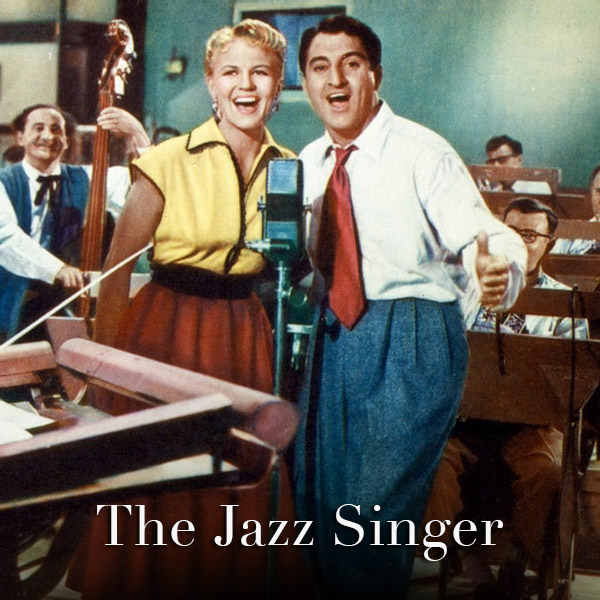Warner Archive / Warner Home Video
Released February 16, 2010
The Warner Archive presents the DVD debut of the 1952 Warner Brothers musical The Jazz Singer, starring Danny Thomas and Peggy Lee, a Technicolor remake of the landmark 1927 film starring Al Jolson.
“Lee Surrenders” read the Los Angeles Times headline on September 7, 1952, for an article about Peggy’s first full musical and dramatic role in a feature film. Over the previous ten years, her film work was limited to musical cameos in features (Stage Door Canteen, The Powers Girl, Mr. Music), musical shorts (Banquet of Melody, Midnight Serenade), and singing for puppet characters in George Pal shorts (Jasper and the Beanstalk, Jasper’s in a Jam). She resisted earlier offers of starring roles in films, mainly for personal reasons. As she told John L. Scott in the Times, “When I was married to Dave Barbour, I decided that keeping a home together [with their young daughter] was pretty important, and there were so many interruptions, what with my radio, TV, records, and personal appearances. Then we broke up anyway, so I figured I might as well try motion pictures too.”
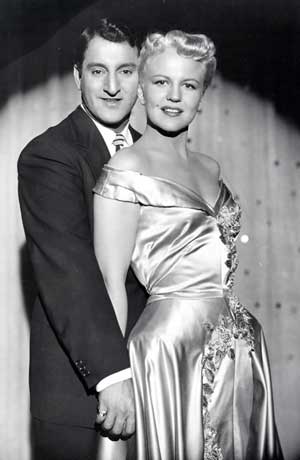 Warner Brothers’ remake of The Jazz Singer dates back to late 1943, when the Los Angeles Examiner reported that Frank Sinatra was considered for the lead role. Two years later, according to the American Film Institute, executive producer Jack L. Warner announced he had selected Dane Clark for the Jolson role. Then came the hugely popular Columbia bio-musicals The Jolson Story (1946) and Jolson Sings Again (1949), and plans for a Jazz Singer remake were revived once more. In April 1952, Warner Brothers announced that it would star Danny Thomas and Doris Day, who had teamed so successfully in the 1951 musical I’ll See You in My Dreams. They would again be directed by Michael Curtiz and produced by Louis F. Edelman.
Warner Brothers’ remake of The Jazz Singer dates back to late 1943, when the Los Angeles Examiner reported that Frank Sinatra was considered for the lead role. Two years later, according to the American Film Institute, executive producer Jack L. Warner announced he had selected Dane Clark for the Jolson role. Then came the hugely popular Columbia bio-musicals The Jolson Story (1946) and Jolson Sings Again (1949), and plans for a Jazz Singer remake were revived once more. In April 1952, Warner Brothers announced that it would star Danny Thomas and Doris Day, who had teamed so successfully in the 1951 musical I’ll See You in My Dreams. They would again be directed by Michael Curtiz and produced by Louis F. Edelman.
Within a few months, the search was on for a new leading lady. It’s not clear whether Day turned down the project (as at least one columnist claimed at the time) or was assigned to another production, as often happened to actors in the studio era. According to the Los Angeles Times, director Curtiz — whose previous credits included Casablanca, Yankee Doodle Dandy and Mildred Pierce — persuaded Peggy to take the role after being so impressed by her performance at a Hollywood nightclub. The fact that she was riding the record charts in the spring and summer of 1952, with her Decca recordings of “Be Anything (But Be Mine),” “Watermelon Weather,” “Just One of Those Things,” and especially “Lover,” surely guided the decision to cast this relative newcomer.
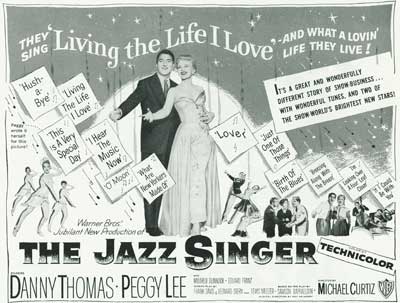 Peggy’s role as nightclub singer Judy Lane enabled her to perform Cole Porter’s “Just One of Those Things” and Rodgers and Hart’s “Lover” in swank club settings. In other sequences, she dueted with Danny Thomas on one of her own compositions, “This Is a Very Special Day,” and on two of the film’s new songs by Sammy Fain and Jerry Seelen, “I Hear the Music Now” and “What Are New Yorkers Made Of?” Lee and Thomas were beautifully supported by the Warner Brothers studio orchestra under the direction of Ray Heindorf, who received the film’s only Academy Award nomination in the category of Best Scoring of a Musical Picture.
Peggy’s role as nightclub singer Judy Lane enabled her to perform Cole Porter’s “Just One of Those Things” and Rodgers and Hart’s “Lover” in swank club settings. In other sequences, she dueted with Danny Thomas on one of her own compositions, “This Is a Very Special Day,” and on two of the film’s new songs by Sammy Fain and Jerry Seelen, “I Hear the Music Now” and “What Are New Yorkers Made Of?” Lee and Thomas were beautifully supported by the Warner Brothers studio orchestra under the direction of Ray Heindorf, who received the film’s only Academy Award nomination in the category of Best Scoring of a Musical Picture.
Critical reaction to the film overall was only mildly positive. “The new Technicolored remake of The Jazz Singer is not likely to make history, technological or otherwise. But it is a slick, streamlined version of the original, and still a good show,” wrote an unnamed Time critic. New York Times critic A.H. Weiler called it “a standard success story that has hardly improved with age. Mr. Thomas and Peggy Lee, the eminent popular songstress who is his romantic vis-a-vis, are joking, wooing, and warbling in a modern idiom, but they are selling unadorned and sometimes corny sentimentality that cannot be disguised by smooth patter or snappy ditties.”
Peggy’s notices were often stronger than those for the film itself. “Songstress Peggy Lee sings brightly and plays the jazz singer’s girlfriend attractively,” wrote Time. “Miss Lee, who is resplendent in a variety of gowns, does not let her fans down,” wrote Weiler in the New York Times.
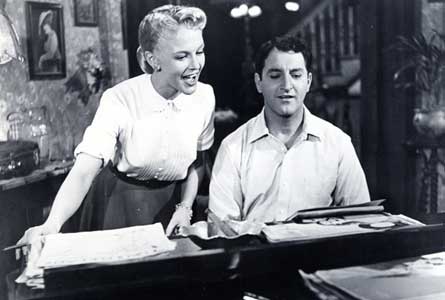 Roy Kohler’s review for the Pittsburgh Press was especially positive:
Roy Kohler’s review for the Pittsburgh Press was especially positive:
“As a consolation The Jazz Singer introduces the chanting of a sure-enough female jazz singer to the screen. She’s Peggy Lee, a girl some jazz fans whose memories stretch back a decade or more can remember singing with the Benny Goodman Orchestra. Her major screen debut is the best thing about the Technicolored film. As a songstress her technique in putting over a melody is easily as listenable as it was in her Benny Goodman days — and that was good enough to win her top female vocal honors in many music polls. As an actress, Miss Lee does much better than should be expected of a singer in a not-so-light dramatic role. Of course, she’s best doing such numbers as ‘Lover’ and ‘Just One of Those Things.’ She’s done them a number of times in nightclubs and on records but somehow they sound even better when watching the vivacious blond sell them. As Judy Lane, a nightclub singer with a crush on a boy training to be a cantor, Miss Lee brings some of its brightest moments to The Jazz Singer. The kind of torchy appeal she gets into her music also gets into her characterization.”
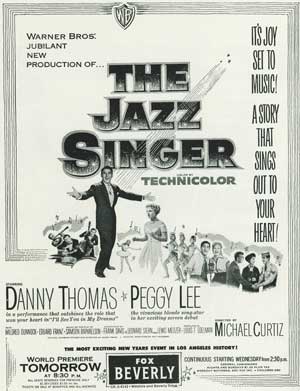 The Warner Archive division was launched in early 2009 as a way to release hundreds of Warner Brothers, MGM, RKO, and other films to the home video market, on both a “made-on-demand” basis (in the DVD-R format) and by digital download. Warner Archive releases are not newly remastered but are taken from the best existing sources. No DVD “extras” are included apart from the film’s theatrical trailer, when available.
The Warner Archive division was launched in early 2009 as a way to release hundreds of Warner Brothers, MGM, RKO, and other films to the home video market, on both a “made-on-demand” basis (in the DVD-R format) and by digital download. Warner Archive releases are not newly remastered but are taken from the best existing sources. No DVD “extras” are included apart from the film’s theatrical trailer, when available.

